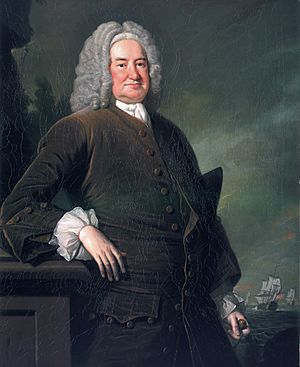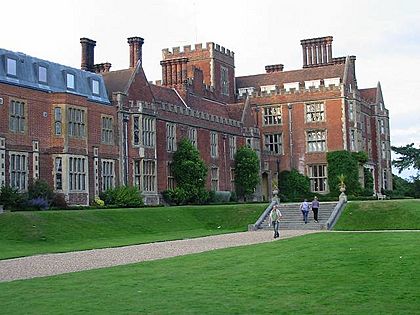John Norris (Royal Navy officer) facts for kids
Quick facts for kids
Sir John Norris
|
|
|---|---|

John Norris by Godfrey Kneller in 1711
|
|
| Nickname(s) | Foul-weather Jack |
| Born | 1670 or 1671 |
| Died | 13 June 1749 Hemsted Park, Benenden, Kent |
| Buried |
St George's Church, Benenden, Kent
|
| Allegiance | |
| Service/ |
|
| Years of service | 1680–1734 |
| Rank | Admiral of the Fleet |
| Commands held | HMS Pelican HMS Spy HMS Sheerness HMS Royal Oak HMS Sussex HMS Russell HMS Carlisle HMS Content HMS Winchester HMS Orford HMS Britannia Mediterranean Fleet |
| Battles/wars | Nine Years' War Williamite War in Ireland War of the Spanish Succession Great Northern War War of Jenkins' Ear |
Admiral of the Fleet Sir John Norris (1670 or 1671 – 13 June 1749) was a brave officer in the Royal Navy. He was also a Whig politician, which means he was involved in the government. People sometimes called him "Foul-weather Jack" because he was known for sailing in bad weather.
Norris started his career as a junior officer. He fought in the Nine Years' War and the Williamite War in Ireland. Later, he led a group of ships to North America. His mission was to protect British settlements in Hudson Bay. He even planned to take back land in Newfoundland and Labrador from the French. But local leaders stopped him from carrying out his plan.
He served under famous admirals like Sir George Rooke. He fought in important battles during the War of the Spanish Succession. These included the Battle of Cádiz and the Battle of Malaga. He also helped capture Barcelona in October 1705.
As a senior officer, Norris led a fleet to the Baltic Sea. He worked with naval forces from Russia, Denmark, and Hanover. In 1716, Tsar Peter of Russia made Norris his second-in-command. Together, they protected British ships from the Swedish Empire during the Great Northern War. Later, Britain changed sides, and Norris protected British ships from Russian attacks. He also helped negotiate the Treaty of Nystad, which ended the war.
In 1739, Norris became Commander-in-Chief of the Channel Fleet. This was at the start of the War of Jenkins' Ear. In 1744, he was asked to defend Britain from a French invasion. He was getting ready to fight the French fleet. But big storms scattered the French invasion ships. This saved Britain from the attack.
John Norris was born around 1670 or 1671. His parents were Irish, but their exact background is not clear. He joined the Royal Navy in 1680. He started as a captain's servant, learning about life at sea.
In 1689, he became a lieutenant. He joined the ship HMS Edgar during the Nine Years' War. He then moved to HMS Monck in 1690. He served off the coast of Ireland during the Williamite War in Ireland.
First Commands and Battles
Norris was promoted to commander in July 1690. He was given command of a fire ship called HMS Pelican. He took part in the Battle of Beachy Head. This was another important battle in the Nine Years' War. In 1691, he commanded another fire ship, HMS Spy. He fought in the Battles of Barfleur and La Hogue in May 1692.
In January 1693, Norris became a captain. He commanded HMS Sheerness. He fought in the Battle of Lagos in June 1693. He then commanded several other ships, including HMS Royal Oak and HMS Russell. He sailed to the Mediterranean in 1694.
Protecting British Settlements
In 1697, Norris led a group of ships to North America. His job was to protect British settlements in Hudson Bay. He planned to take back land in Newfoundland and Labrador from the French. But the local council stopped him. When he returned to England, some people criticized him. However, a powerful leader, the Earl of Orford, defended him.
Norris continued his successful career. He commanded HMS Winchester later in 1697. But in 1699, investigations into his actions in Newfoundland started again. He was temporarily suspended from the navy.
Return to Action
Norris was back in command of HMS Orford in 1702. He served under Admiral Sir George Rooke at the Battle of Cádiz. This was an early part of the War of the Spanish Succession. He then led the front line of ships at the Battle of Malaga in August 1704.
In 1703, he commanded HMS Britannia. This was the main ship of Admiral Sir Cloudesley Shovell. He then served under the Earl of Peterborough. He helped capture Barcelona in October 1705. After returning to England, he was made a knight on November 5, 1705.
Rising Through the Ranks

Norris was promoted to rear admiral in March 1707. He became the second-in-command of the Mediterranean Fleet. His flag was on the ship HMS Torbay. He took part in the British defeat at the Battle of Toulon in July 1707.
In October 1707, Norris was on HMS Torbay during a terrible naval disaster. This happened off the Isles of Scilly. Admiral Shovell and four of his ships were lost. Nearly 2,000 sailors died.
Norris was promoted to vice admiral in January 1708. He moved his flag to HMS Ranelagh. He also became a Member of Parliament for Rye. He supported the Whig party. While at sea, he didn't spend much time in Parliament.
He led a group of ships to the Baltic Sea in 1709. His goal was to stop Swedish grain from reaching France. In December 1709, he became a full admiral. He then became Commander-in-Chief of the Mediterranean Fleet in 1710.
Political Changes and Return to Service
Norris was re-elected as an MP for Rye in 1710. A new government took away his command in October 1711. This allowed him to focus more on Parliament. He kept a close eye on the war and naval matters.
He was re-elected again in 1713 and 1715. With a new Whig government, he returned to active duty. He led a fleet to the Baltic Sea to help Russia, Denmark, and Hanover in the Great Northern War.
Working with Peter the Great
In 1716, Tsar Peter of Russia took command of the allied fleet. He made Norris his deputy. Together, they protected British and allied merchant ships. They kept them safe from Swedish warships.
Norris joined the Board of Admiralty in March 1718. This board managed the navy. In November 1718, Charles XII of Sweden died. Britain then changed sides in the war. Norris returned to the Baltic to protect British ships from Russian attacks. He also helped negotiate the Treaty of Nystad. This treaty ended the Great Northern War in September 1721.
In 1722, he became an MP for Portsmouth. In June 1727, he became the Senior Naval Lord on the Admiralty Board. But he stepped down in May 1730 when the government changed.
Leading Fleets and Final Years
Norris lost his position on the Admiralty Board in 1730. He also lost his command in 1731. In Parliament, he joined the group that opposed the government.
Admiral of the Fleet
In 1734, the government reached an agreement with him. He was promoted to Admiral of the Fleet on February 20, 1734. He commanded a fleet sent to the Iberian Peninsula. His mission was to protect Portugal from Spanish attack.
He was re-elected as an MP for Rye in 1734. In April 1739, he became Vice-Admiral of Great Britain. He then became Commander-in-Chief of the Channel Fleet. This was at the start of the War of Jenkins' Ear in autumn 1739.
Defending Britain
In 1744, Norris was asked to defend Britain from a French invasion. In 1745, he became Captain of Deal Castle. He was preparing his ships to fight the French fleet. But powerful storms hit, scattering the French invasion ships. Many lives were lost, and the invasion threat ended. Norris retired from the navy later that year.
Sir John Norris died at his home, Hemsted Park in Kent, on June 13, 1749. He was buried at St George's Church in Benenden. His tomb was made by a sculptor named Peter Scheemakers.
Family Life
In May 1699, John Norris married Elizabeth Aylmer. She was the daughter of Admiral Matthew Aylmer. They had five children together. These included Vice Admiral Henry Norris and Captain Richard Norris, who also served in the navy. His granddaughter, John Norris Hewett, became an art collector and artist.



